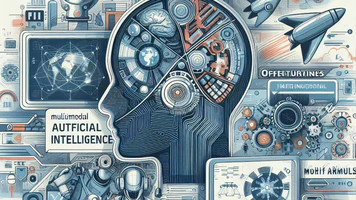
- By Justin Riddiough
- December 9, 2023
Imagine a world where machines can understand not just words and numbers, but also the richness of images, sounds, and videos. This is the reality of multimodal models, complex algorithms that process information from multiple modalities (e.g., text, images, audio) to achieve a deeper understanding of the world. But how do these models work their magic?
Feature Extraction: Building the Blocks of Understanding
Just like humans rely on their senses to gather information, multimodal models rely on feature extraction to extract relevant information from each modality. This involves techniques like:
- Convolutional Neural Networks (CNNs): Excellent for capturing visual features like shapes, edges, and textures in images and videos.
- Recurrent Neural Networks (RNNs): Capture sequential information from audio signals and text, understanding the order and flow of words and sounds.
- Word Embeddings: Represent the meaning of words in a numerical format, allowing models to understand the semantic relationships between words.
These extracted features are the building blocks for model understanding. They act as the raw materials that are further processed by the model to perform tasks like image captioning, video summarization, and sentiment analysis.
Fusion Strategies: Bringing the Modalities Together
But simply extracting features is not enough. Multimodal models need to fuse information from different modalities to create a unified representation of the data. This is where fusion strategies come in. Here are some common approaches:
- Early Fusion: Combines the features from different modalities at the earliest stage, creating a single representation for further processing.
- Late Fusion: Processes each modality independently and then combines the learned representations at a later stage.
- Multimodal Attention: Allows the model to focus on the most relevant parts of each modality, dynamically weighing their contributions based on the task and context.
Fusion is the glue that holds together the different components of a multimodal model. Effective fusion strategies lead to more accurate and robust models.
Attention Mechanisms: Focusing on What Matters
Multimodal data can be complex and noisy. To ensure the model focuses on the most relevant information, attention mechanisms are employed. These mechanisms allow the model to selectively attend to specific parts of each modality, prioritizing the information that is most important for the task at hand.
Think of it like focusing your attention on a specific speaker in a crowded room. You can still hear the other conversations, but your attention is drawn to the speaker you are focusing on. Similarly, attention mechanisms allow the model to zoom in on the most relevant information, leading to better performance and understanding.
Building a Symphony of Understanding
By combining feature extraction, fusion strategies, and attention mechanisms, multimodal models are able to achieve remarkable feats of understanding. They can analyze complex data, capture subtle nuances, and generate insightful results. As research continues, we can expect these models to play an increasingly important role in various fields, from healthcare and education to entertainment and robotics.
The future of technology lies in understanding the world as holistically as humans do. By combining information from multiple senses, multimodal models are paving the way for a future where machines can not only process information but also truly understand the world around them.


